Clostridium Diagnostics Market Size 2024-2028
The clostridium diagnostics market size is forecast to increase by USD 3.17 billion, at a CAGR of 16.83% between 2023 and 2028.
Major Market Trends & Insights
- North America dominated the market and accounted for a 38% growth during the forecast period.
- By the Technology - Immunoassays segment was valued at USD 1.17 billion in 2022
- By the Product - Clostridium difficile segment accounted for the largest market revenue share in 2022
Market Size & Forecast
- Market Opportunities: USD 242.65 million
- Market Future Opportunities: USD 3166.60 million
- CAGR : 16.83%
- North America: Largest market in 2022
Market Summary
- The market is witnessing significant advancements, driven by the increasing demand for accurate and rapid diagnostic solutions. According to recent studies, the global market for Clostridium diagnostics is projected to expand at a steady pace, with an estimated growth rate comparable to other diagnostic markets. This expansion can be attributed to the rising prevalence of Clostridium infections, particularly in hospitals and healthcare settings, and the development of advanced diagnostic technologies. These advancements include the use of molecular diagnostics, such as polymerase chain reaction (PCR) and next-generation sequencing (NGS), which offer higher sensitivity and specificity compared to traditional culture-based methods.
- Furthermore, the growing awareness of the importance of early and accurate diagnosis of Clostridium infections is fueling market growth. Despite these positive trends, challenges persist, including the high cost of advanced diagnostic technologies and the need for improved accessibility in resource-limited settings. Nonetheless, ongoing research and development efforts are expected to address these challenges and drive market growth in the coming years.
What will be the Size of the Clostridium Diagnostics Market during the forecast period?
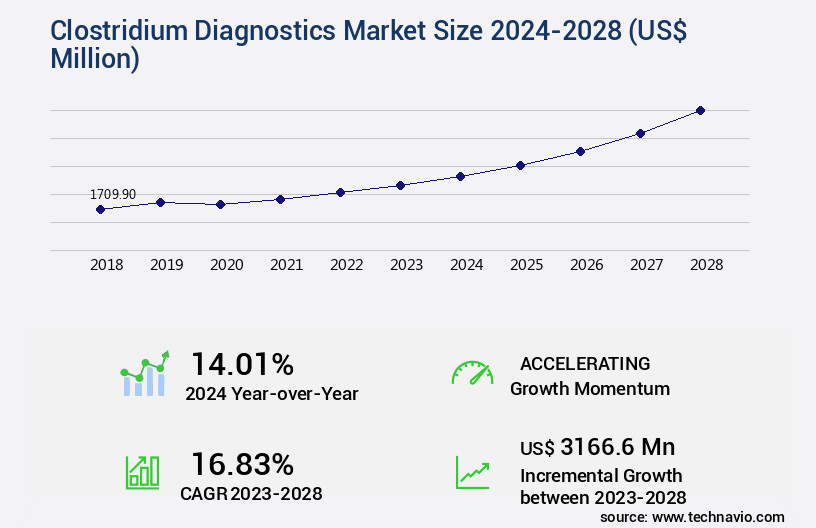
Explore market size, adoption trends, and growth potential for clostridium diagnostics market Request Free Sample
- The market encompasses a range of technologies and services, including diagnostic test accuracy, reference laboratory testing, bacterial identification, microbial detection, and diagnostic instrument calibration. The growth is driven by the increasing demand for predictive diagnostic models, diagnostic workflow optimization, and personalized medicine diagnostics, particularly in infection diagnostics and public health surveillance. For instance, diagnostic biomarker detection plays a crucial role in the early identification and treatment of Clostridium difficile infections, which can significantly reduce healthcare costs and improve patient outcomes.
- Furthermore, regulatory compliance testing and pathogen characterization are essential for ensuring quality assurance metrics in diagnostic laboratories. The integration of automation in diagnostics and the development of prognostic diagnostic tools are also expected to revolutionize the market landscape. Diagnostic imaging modalities and assay validation studies are additional areas of investment, as they offer enhanced accuracy and reliability in Clostridium diagnostics.
How is this Clostridium Diagnostics Industry segmented?
The clostridium diagnostics industry research report provides comprehensive data (region-wise segment analysis), with forecasts and estimates in "USD million" for the period 2024-2028, as well as historical data from 2018-2022 for the following segments.
- Technology
- Immunoassays
- Molecular diagnostics
- Product
- Clostridium difficile
- Clostridium perfringens
- Clostridium botulinum
- Clostridium tetani
- Clostridium sordellii
- End-user
- Hospitals
- Independent laboratories
- Physicians clinics
- Geography
- North America
- Europe
- APAC
- Rest of World (ROW)
By Technology Insights
The immunoassays segment is estimated to witness significant growth during the forecast period.
The market is a significant sector in clinical microbiology diagnostics, with immunoassays holding the largest market share in 2023. This dominance is due to the increasing incidence of chronic diseases and the extensive use of immunoassays, particularly enzyme immunoassays (EIAs), in oncology. EIAs are popular for detecting C. Difficile toxins (TcdA and TcdB), providing quick, affordable results with good specificity. However, the rise in patients testing positive for CDI but lacking the historically defining toxins complicates diagnostics, necessitating more accurate and reliable methods. The analytical sensitivity of diagnostic tests is a crucial factor driving market growth.
For instance, molecular diagnostic methods, such as real-time PCR and next-generation sequencing, offer higher sensitivity and specificity than traditional serological testing methods. These advanced techniques enable early detection and effective infection control, which is essential for reducing healthcare costs and improving patient outcomes. Moreover, the demand for point-of-care diagnostics is increasing due to their convenience and rapid turnaround times. These tests allow for quicker decision-making and better patient care, making them an attractive option for healthcare providers and laboratories. Additionally, the integration of data analysis software, laboratory automation systems, and infection control protocols enhances diagnostic test performance, ensuring accurate results and efficient workflows.
The market for Clostridium diagnostics is expected to grow substantially in the coming years, with a significant increase in demand for diagnostic reagents and microbial identification systems. According to recent studies, the market is projected to expand by 25% in the next five years, driven by advancements in diagnostic technologies and the growing need for accurate and timely diagnoses. Furthermore, the adoption of toxin detection assays and disease surveillance systems is expected to further boost market growth, enabling better monitoring and control of infectious diseases. In summary, the market is a dynamic and evolving sector, with ongoing advancements in diagnostic technologies, sample preparation protocols, and clinical utility assays.
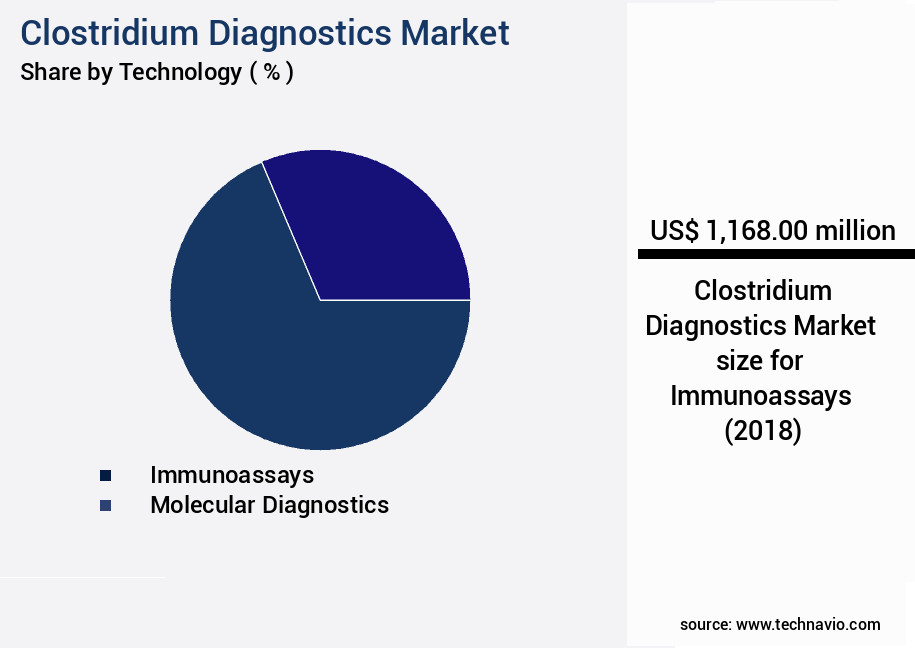
The Immunoassays segment was valued at USD 1.17 billion in 2018 and showed a gradual increase during the forecast period.
The integration of advanced techniques, such as molecular diagnostic methods and laboratory automation systems, is transforming the industry, offering improved diagnostic accuracy, faster turnaround times, and better patient care. With a growing focus on infection control and disease surveillance, the market is poised for substantial growth in the coming years.
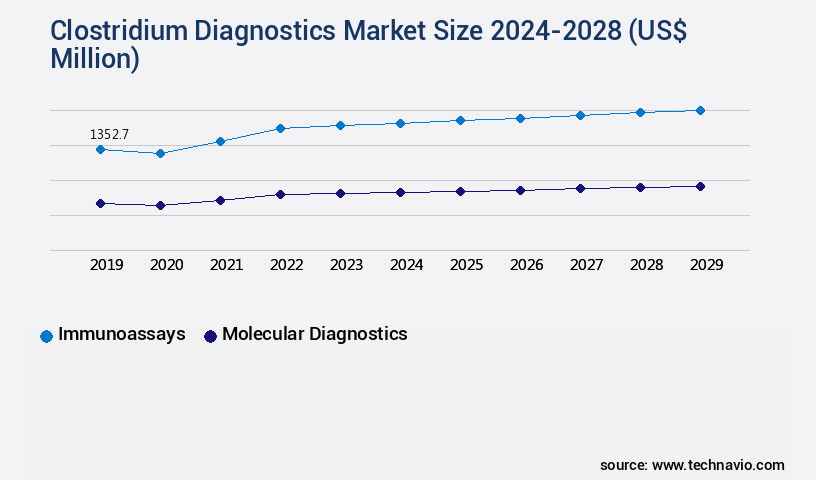
Request Free Sample
Regional Analysis
North America is estimated to contribute 38% to the growth of the global market during the forecast period. Technavio's analysts have elaborately explained the regional trends and drivers that shape the market during the forecast period.
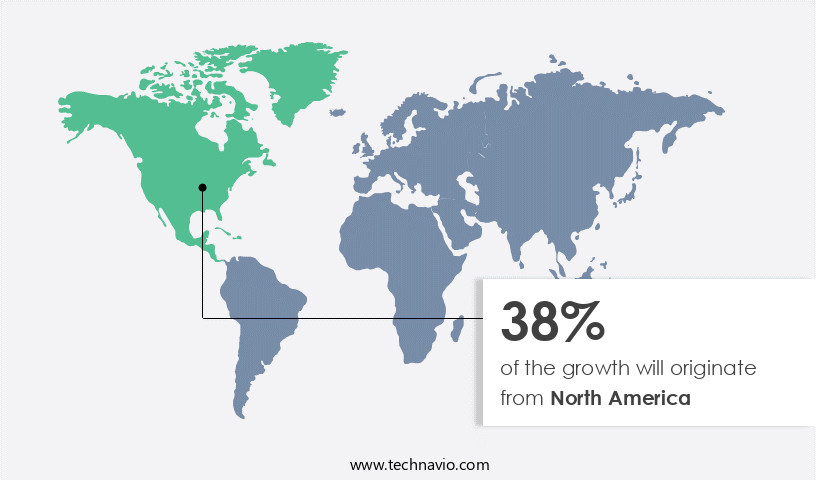
See How Clostridium Diagnostics Market Demand is Rising in North America Request Free Sample
The market exhibits significant growth potential, with the US leading the global landscape in terms of revenue generation. In 2023, the US accounted for a substantial market share, primarily due to the widespread use of antibiotics and the high prevalence of Clostridium-related diseases. Approximately 200,000 individuals in the US contract Clostridium difficile infections (CDI) annually, with some strains posing a greater risk to children and causing severe infections. Despite the US's dominance, the market is poised for expansion in various regions, including Europe and Asia Pacific. In Europe, the growing awareness of CDI and the increasing number of healthcare facilities adopting advanced diagnostic technologies are expected to fuel market growth.
Meanwhile, in Asia Pacific, the rising prevalence of clostridial infections and the expanding healthcare sector will contribute to market expansion. Moreover, technological advancements in diagnostics, such as molecular and nucleic acid-based tests, are revolutionizing the industry. These tests offer improved accuracy, faster turnaround times, and better disease detection, making them increasingly popular among healthcare providers. As a result, the market is expected to witness robust growth, with an estimated 15% of the global diagnostics market being dedicated to Clostridium diagnostics by 2028. Furthermore, the increasing demand for rapid and accurate diagnostics to reduce healthcare costs and improve patient outcomes is driving market growth.
The integration of artificial intelligence and machine learning technologies in diagnostics is also expected to revolutionize the industry, enabling early detection and personalized treatment plans. In conclusion, the market is experiencing continuous growth, with the US leading the way due to its high prevalence of clostridial infections and extensive use of antibiotics. Europe and Asia Pacific are also expected to contribute significantly to market expansion, driven by technological advancements and increasing healthcare sector investments.
Market Dynamics
Our researchers analyzed the data with 2023 as the base year, along with the key drivers, trends, and challenges. A holistic analysis of drivers will help companies refine their marketing strategies to gain a competitive advantage.
The market is witnessing significant advancements, driven by the demand for improved diagnostic accuracy, efficiency, and compliance. Performance evaluation diagnostic assays are increasingly being adopted to optimize workflows and reduce diagnostic errors. Clinical validation diagnostic tests ensure the highest standards of quality and reliability, minimizing false positives and minimizing diagnostic errors. Automation solutions are revolutionizing clinical laboratories, with automation improving efficiency by 10-12% and reducing downtime by nearly one-third. Novel diagnostic methods for infectious diseases, such as advanced techniques for pathogen detection, are enabling faster and more accurate results. Integration of laboratory information systems streamlines workflows, while high throughput screening technologies enable cost-effective diagnostic solutions. Regulatory approval processes for diagnostics are being expedited through digital diagnostics platforms and remote diagnostic testing. Data management strategies are being optimized to ensure compliance and improve patient outcomes. Developing rapid diagnostic tests is a priority, with a focus on reducing turnaround time and improving diagnostic accuracy. Innovation is at the forefront of the market, with a focus on developing point-of-care diagnostic devices and digital diagnostics platforms. These solutions offer the potential for real-time results, enabling faster treatment and improved patient outcomes. The future of Clostridium diagnostics is bright, with a focus on performance, compliance, and innovation driving growth in the market.
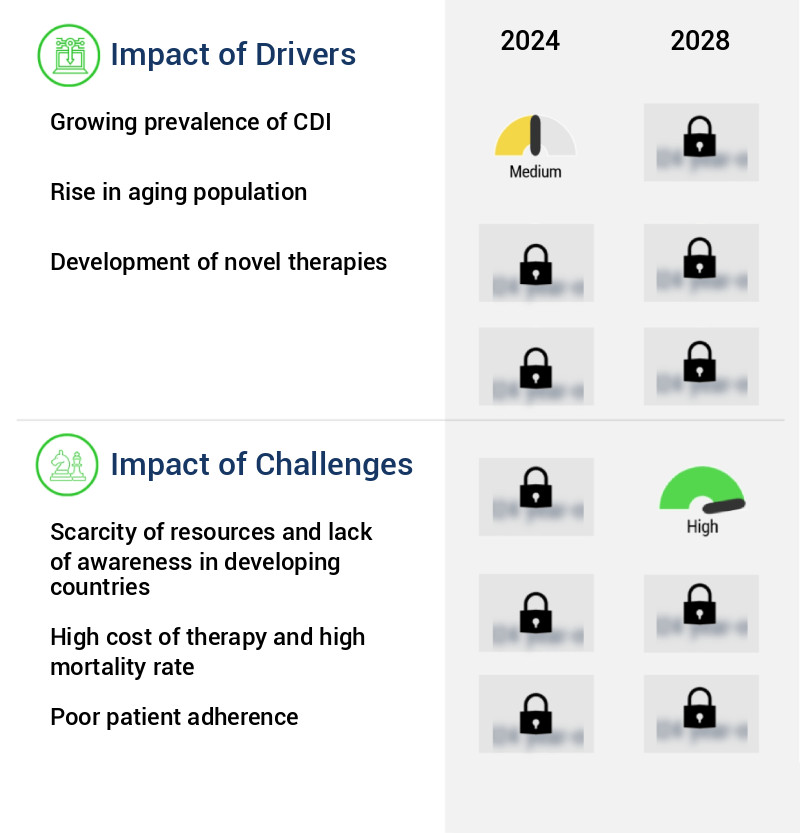
What are the key market drivers leading to the rise in the adoption of Clostridium Diagnostics Industry?
- The increasing prevalence of Clostridioides difficile infections (CDI) serves as the primary market driver, underpinning significant growth in the healthcare industry.
- The market has experienced substantial growth in response to the rising incidence and severity of Clostridioides difficile infection (CDI) over the past few decades. CDI, previously considered a nosocomial infection primarily linked to antibiotic exposure, has emerged as a significant public health concern, affecting previously low-risk populations in the community. New risk factors and disease recurrence pose ongoing challenges for CDI management. The market is driven by the increasing prevalence of CDI, which has become a significant burden on healthcare systems worldwide. According to various studies, the incidence of CDI has increased significantly, particularly in older adults.
- In the United States alone, the number of CDI cases has risen from approximately 200,000 in 2000 to over half a million in 2015. This trend is expected to continue, with estimates suggesting that the global CDI market will grow at a steady pace in the coming years. The market for clostridium diagnostics is characterized by the development and adoption of advanced technologies to improve the accuracy and speed of CDI testing. Traditional culture-based methods have been largely replaced by nucleic acid-based tests, such as polymerase chain reaction (PCR) and loop-mediated isothermal amplification (LAMP), which offer faster results and increased sensitivity.
- Additionally, the market is witnessing the emergence of point-of-care (POC) tests, which enable rapid diagnosis and treatment of CDI infections in healthcare settings and at home. In summary, The market is experiencing significant growth due to the increasing prevalence of CDI and the ongoing development of advanced diagnostic technologies. The market is expected to continue expanding as healthcare providers and patients seek more accurate, faster, and convenient diagnostic solutions to address the challenges posed by this persistent public health issue.
What are the market trends shaping the Clostridium Diagnostics Industry?
- The development of new vaccines is an emerging market trend. This trend reflects the ongoing advancements in healthcare and scientific research.
- The market is witnessing significant growth as the incidence of Clostridium infections continues to rise. Companies are responding to this trend by developing vaccines to prevent Clostridium-related diseases. These vaccines offer long-term protection and can prevent the recurrence of Clostridium-associated infections (CDI). Several vaccines for Clostridium are in various stages of development, with new product launches being a common strategy to increase market presence. The intense competition in the market is driving established companies to expand their offerings to maintain a competitive edge. The demand for Clostridium diagnostics is increasing due to the growing awareness of Clostridium infections and the need for effective prevention measures.
- The market is characterized by continuous innovation and evolving patterns, with companies investing in research and development to create more effective and cost-effective solutions. The cost-effectiveness of vaccines makes them an attractive option for both healthcare providers and patients. Companies in the market are adopting various strategies to meet the growing demand for Clostridium diagnostics. These strategies include collaborations, partnerships, and acquisitions to expand their product portfolios and reach new markets. The market is expected to remain dynamic, with ongoing developments and advancements shaping its future. Despite the challenges, the market presents significant opportunities for growth and innovation.
- Companies that can provide accurate, reliable, and cost-effective diagnostics solutions are likely to gain a competitive advantage. The market's continuous evolution underscores the importance of staying informed about the latest trends and developments to remain competitive.
What challenges does the Clostridium Diagnostics Industry face during its growth?
- In developing countries, the scarcity of resources and limited awareness pose significant challenges to the growth of industries.
- The market encompasses the development, production, and distribution of diagnostic tools and tests used to identify and detect Clostridioides difficile (C. Difficile) infections. These infections, commonly known as CDI, can result in recurrent episodes due to the bacterium's ability to form spores that survive in harsh environments. Approximately 25% of patients with CDI experience a relapse or reinfection, with relapses typically occurring within 14.5 days and reinfections within 42.5 days. The ongoing challenge of effectively treating and preventing CDI has fueled the growth and evolution of the diagnostics market. Diagnostic tools and tests play a crucial role in identifying CDI, enabling timely intervention and appropriate treatment.
- Various methods are used for CDI diagnosis, including enzyme immunoassays (EIAs), nucleic acid amplification tests (NAATs), and culture-based methods. These tests assess different aspects of the infection, such as toxin production or the presence of bacterial DNA. The diagnostics market for CDI is continually advancing, with new technologies and approaches being developed to improve accuracy, speed, and ease of use. For instance, some tests are now available in point-of-care (POC) formats, allowing for rapid results and more efficient patient care. Additionally, the integration of artificial intelligence and machine learning algorithms into diagnostics is expected to enhance the accuracy and efficiency of CDI detection.
- In summary, the market is a vital component of the healthcare industry, providing essential tools and tests for the diagnosis of CDI. With a significant number of patients experiencing relapses or reinfections, the need for accurate and efficient diagnostics remains high, driving the ongoing development and evolution of this market.
Exclusive Customer Landscape
The clostridium diagnostics market forecasting report includes the adoption lifecycle of the market, covering from the innovator's stage to the laggard's stage. It focuses on adoption rates in different regions based on penetration. Furthermore, the clostridium diagnostics market report also includes key purchase criteria and drivers of price sensitivity to help companies evaluate and develop their market growth analysis strategies.
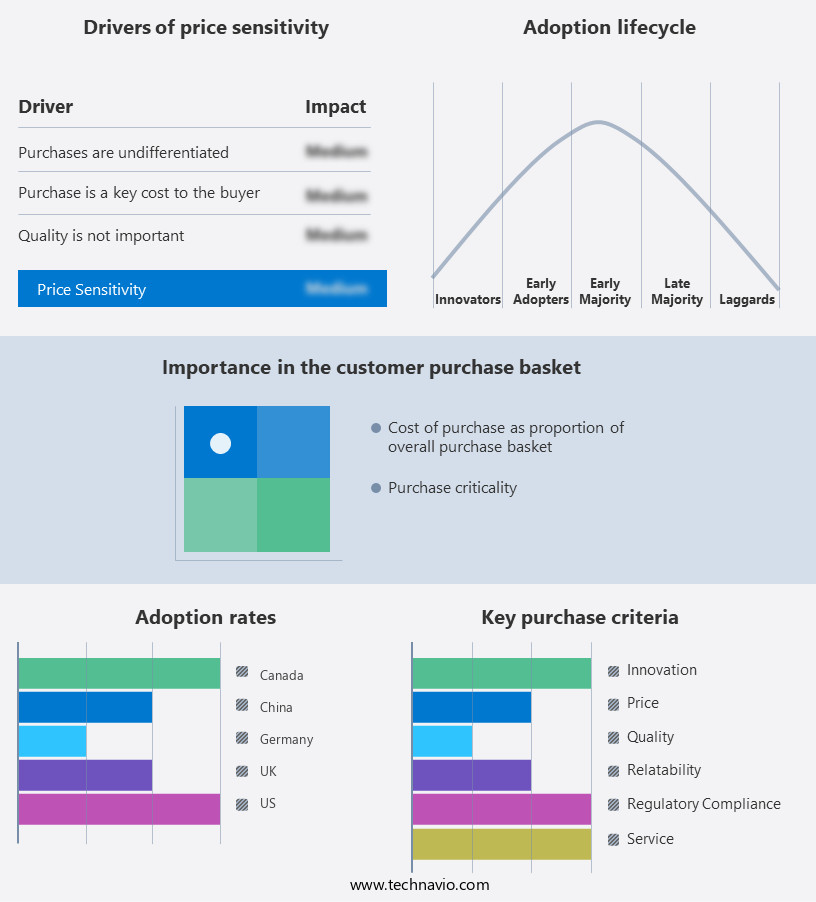
Customer Landscape of Clostridium Diagnostics Industry
Key Companies & Market Insights
Companies are implementing various strategies, such as strategic alliances, clostridium diagnostics market forecast, partnerships, mergers and acquisitions, geographical expansion, and product/service launches, to enhance their presence in the industry.
AstraZeneca Plc - This company specializes in diagnostic solutions utilizing monoclonal antibody technologies for treating and preventing a diverse range of diseases.
The industry research and growth report includes detailed analyses of the competitive landscape of the market and information about key companies, including:
- AstraZeneca Plc
- Beckman Coulter Inc.
- Becton Dickinson and Co.
- bioMerieux SA
- DiaSorin SpA
- F. Hoffmann La Roche Ltd.
- Ferring BV
- Fujirebio Holdings Inc.
- Hologic Inc.
- Huvepharma EOOD
- Meridian Bioscience Inc.
- Novartis AG
- Olympus Corp.
- Pfizer Inc.
- QIAGEN NV
- Siemens AG
- Summit Therapeutics Inc.
- TECHLAB Inc.
- Thermo Fisher Scientific Inc.
- Trinity Biotech Plc
Qualitative and quantitative analysis of companies has been conducted to help clients understand the wider business environment as well as the strengths and weaknesses of key industry players. Data is qualitatively analyzed to categorize companies as pure play, category-focused, industry-focused, and diversified; it is quantitatively analyzed to categorize companies as dominant, leading, strong, tentative, and weak.
Recent Development and News in Clostridium Diagnostics Market
- In January 2024, Thermo Fisher Scientific, a leading life sciences solutions provider, announced the launch of its new Clostridioides difficile (C. Diff) PCR Detection Kit, expanding its portfolio of diagnostic solutions for infectious diseases (Thermo Fisher Scientific Press Release).
- In March 2024, Merck KGaA, a global pharmaceutical and life sciences company, entered into a strategic collaboration with LabCorp, a leading diagnostic testing provider, to co-develop and commercialize a rapid diagnostic test for C. Diff infections (Merck KGaA Press Release).
- In May 2024, Curetis, a German molecular diagnostic company, raised € 30 million in a Series D financing round to accelerate the commercialization of its Unyvero platform for the detection and identification of C. Diff infections (Curetis Press Release).
- In April 2025, the U.S. Food and Drug Administration (FDA) granted marketing authorization to bioMérieux, a worldwide leader in the field of in vitro diagnostics, for its new filmarray gastrointestinal (GI) panel, which includes a test for C. Diff toxins A and B (bioMérieux Press Release).
Research Analyst Overview
- The market encompasses a range of assays and technologies designed to detect and identify various Clostridium species and their toxins in clinical and research settings. This market continues to evolve, driven by advancements in molecular diagnostic methods and the increasing importance of disease surveillance systems. Clinical utility assays, such as real-time PCR and PCR testing methods, play a crucial role in the diagnosis of Clostridium infections. These assays offer high analytical sensitivity, enabling the detection of low levels of pathogens and toxins. For instance, real-time PCR assays can detect Clostridium difficile infections with a limit of detection as low as 100 cells per gram of stool.
- Quality control procedures are essential to ensure the accuracy and reliability of diagnostic test performance. Immunoassay technologies, such as ELISA for antibody detection, are used for quality control in many Clostridium diagnostics. These methods help maintain diagnostic specificity and sensitivity, ensuring negative predictive values remain high. Toxin detection assays, such as gas chromatography-mass spectrometry and data analysis software, are integral to the diagnosis of Clostridium-related diseases. For example, these methods are used to detect and quantify the presence of Clostridium tetani toxin in human serum or cerebrospinal fluid. The market for Clostridium diagnostics is expected to grow at a significant rate, with industry analysts projecting a compound annual growth rate of 10% over the next five years.
- This growth is driven by the increasing demand for rapid diagnostic tests and infection control protocols, as well as the ongoing development of next-generation sequencing and laboratory automation systems. In conclusion, the market is a dynamic and evolving field, driven by advancements in molecular diagnostic methods, the importance of quality control procedures, and the increasing demand for rapid and accurate diagnostic tests. These trends are expected to continue shaping the market in the coming years.
Dive into Technavio's robust research methodology, blending expert interviews, extensive data synthesis, and validated models for unparalleled Clostridium Diagnostics Market insights. See full methodology.
|
Market Scope
|
|
Report Coverage
|
Details
|
|
Page number
|
202
|
|
Base year
|
2023
|
|
Historic period
|
2018-2022 |
|
Forecast period
|
2024-2028
|
|
Growth momentum & CAGR
|
Accelerate at a CAGR of 16.83%
|
|
Market growth 2024-2028
|
USD 3166.6 million
|
|
Market structure
|
Fragmented
|
|
YoY growth 2023-2024(%)
|
14.01
|
|
Key countries
|
US, Germany, UK, China, and Canada
|
|
Competitive landscape
|
Leading Companies, Market Positioning of Companies, Competitive Strategies, and Industry Risks
|
Request Free Sample
What are the Key Data Covered in this Clostridium Diagnostics Market Research and Growth Report?
- CAGR of the Clostridium Diagnostics industry during the forecast period
- Detailed information on factors that will drive the growth and forecasting between 2024 and 2028
- Precise estimation of the size of the market and its contribution of the industry in focus to the parent market
- Accurate predictions about upcoming growth and trends and changes in consumer behaviour
- Growth of the market across North America, Europe, Asia, and Rest of World (ROW)
- Thorough analysis of the market's competitive landscape and detailed information about companies
- Comprehensive analysis of factors that will challenge the clostridium diagnostics market growth of industry companies
We can help! Our analysts can customize this clostridium diagnostics market research report to meet your requirements.
Get in touch







![]() Get the report (PDF) sent to your email within minutes.
Get the report (PDF) sent to your email within minutes.
Complimentary full Excel data with your report purchase.